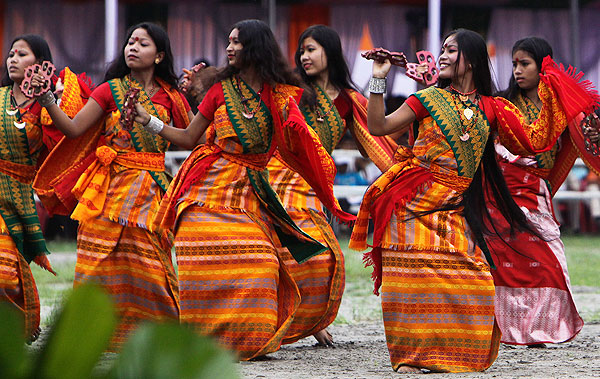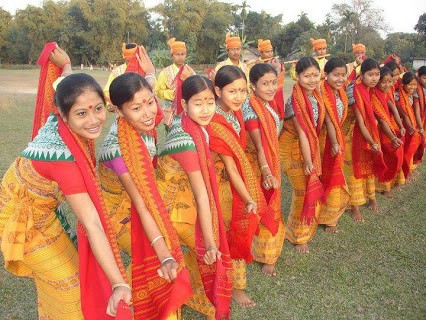Folk Dance Bagurumba Of Assam
The north-eastern state of Assam is home to many tribal communities. Located in the south-eastern flank of Himalayas, Assam is incredibly rich in history, culture and biodiversity. There are three groups of people that form the entire population of the state: the tribal, the non-tribal and the scheduled class people. Seventeen different tribes constitute the ethno-diverse tribal community that merged in the population from times beyond. Some of the notable tribes include the Bodos, the Mishing tribe, Deori tribe, Rabha tribe, Karbi, Nagas and the Garos. Bagurumba dance is performed by Bodo community, the Aboriginal people derived from Tibeto-Burman settlers in the state.
The initial use of the term ‘Bodo’ was to refer certain linguistic group used by B.H. Hodgson during the year 1847 and the language was gradually assigned to certain inhabitants who spoke that dialect. Thus the ethnic community came to be known as the Bodos who are also popular as the Kacharis. The term ‘kachar’ denotes the area close to the river. The famous spring time dance of Bodos is called Bagurumba dance. The dance offers a ritualistic homage to the deity of Bodos and enacted with vivacious spirit and craftsmanship. It is one of the most joyful experiences of Bodo community whose hard work and toil ultimately welcomes this much awaited glorious performances of dance and music.
History
Bodo dance goes by the sobriquet of ‘butterfly dance’ since the dance movement resembles the motion of butterflies. Though the dance form has been existing since pre historic times, there is not much recorded evidence of it anywhere. Bodo-Kacharis of Assam worship revered God Bathow Bwrai who is their equivalent of Lord Shiva among Hindus. During the auspicious eve of Bishuba Sankranti which usually occurs in the middle of April, the holy Bathow is rendered with chicken and zou ( rice beer ). After the homage, Bodo women perform their ritualistic dance wearing gorgeous dokhna, colorful jwmgra and aronai moving gracefully with the music. Some also refer to the dance form as Bardwisikhla dance. The splendid dancing score of young girls performing the dance can be seen in Bodo occupied areas such as Kokrajhar, Nalbari, Darrang, Bongaigaon and Sonitpur districts.
Musical Instruments
Most of the traditional Bodo instruments are given below that are used to accompany the Bagurumba dances.
Siphung - It is a long five-holed flute that produces much lower notes than the regular North Indian flutes. It is also made of bamboo.
Serja – It is a bowed instrument that has a basic design with a circular resonant body and a forward facing scroll.
Tharkha – it is a piece of split bamboo used for percussion.
Kham – This is a longitudinal drum.
Khawang – These are a pair of small cymbals held together with a rope. It is similar to a Namghar.
Significance
As per the Bodo mythology, the Bagurumba dance is favored by a supreme deity called ‘Bathou’ represented by the Sizu Plant that belong to the Euphorbia Genus. The nature of the dance is peaceful and yet it represents the vitality of the spring. The origin of the Bagurumba may be found in the original naturalistic beliefs of the Bodo tribes, as its few songs are just simple images of nature.
Variations
There are only two variants of Bagurumba that are Natural and Royal Bagurumba.
While the Natural Bugurumba is performed with only instrumental music, the Royal Bagurumba performances incorporate songs and vocalist music.












No comments:
Post a Comment